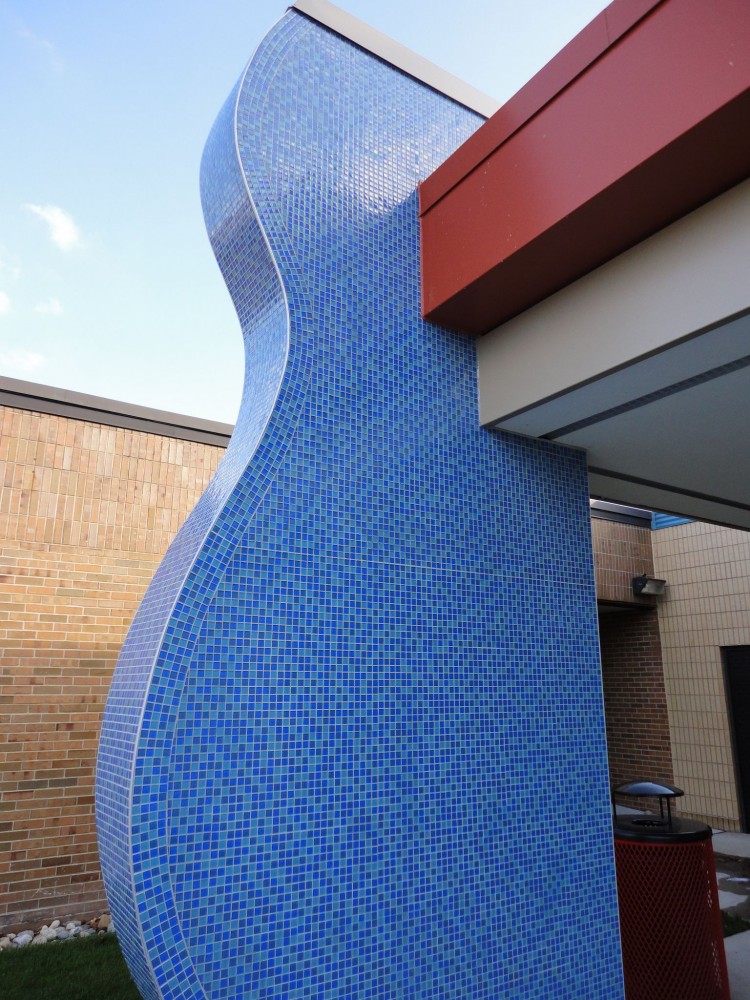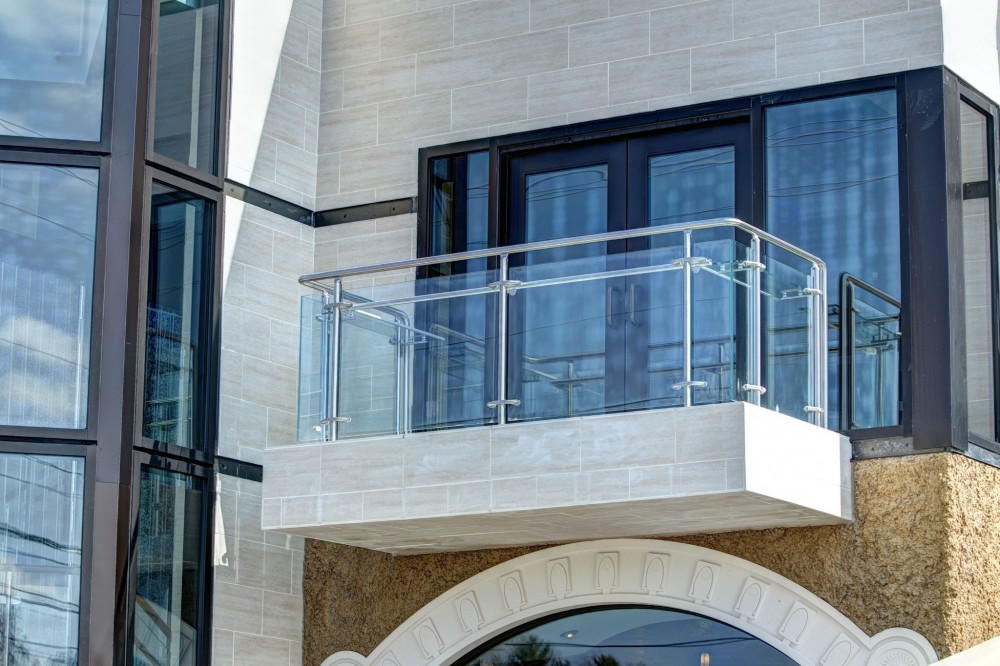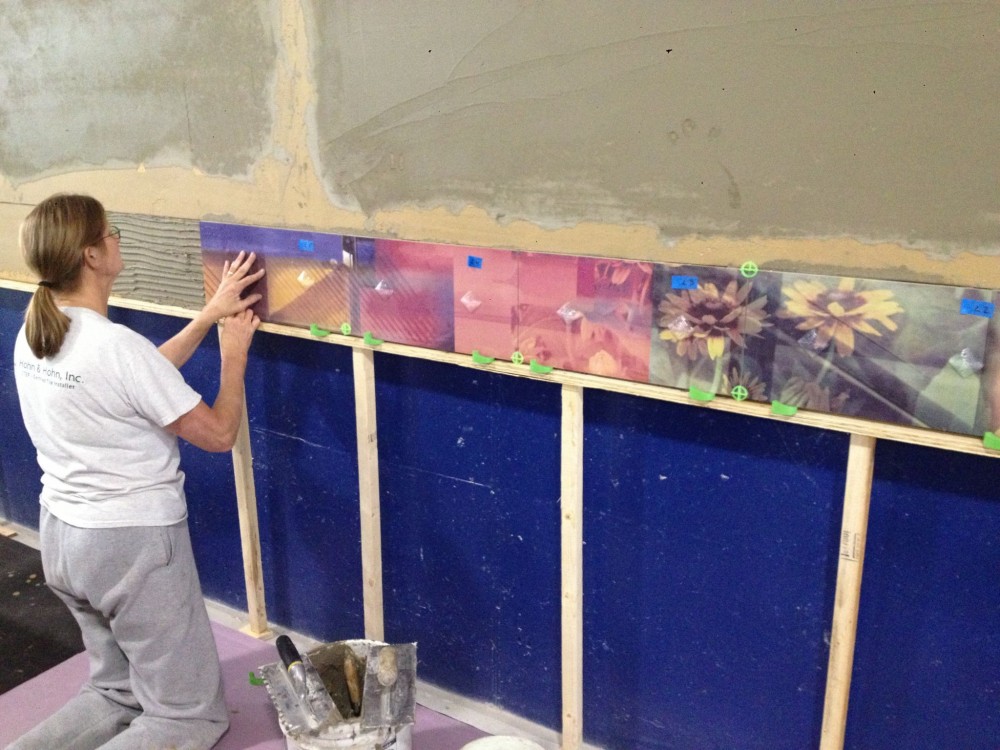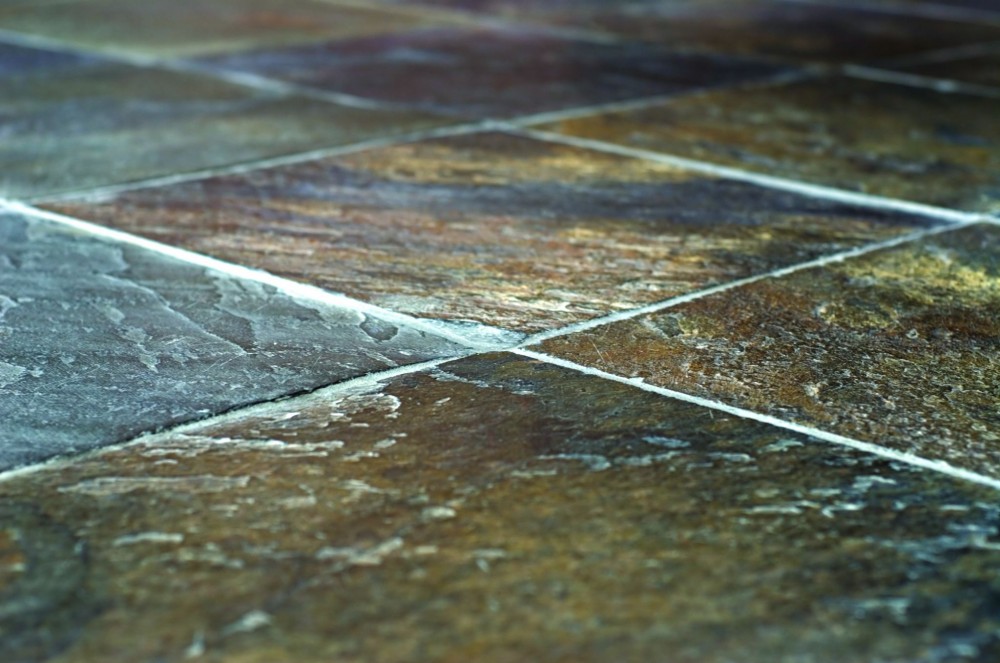Designing for Exterior Tiles: Applications from specification to installation
by Molly Doyle | October 27, 2014 12:15 pm
 [1]
[1]by Tom Plaskota, CDT
Tiled walls, patios, and walkways make a powerful first impression. A well-executed exterior installation can attract customers to a business, or finish off a public space. Although worthwhile, exterior installations present potential complications requiring the examination of many factors.
The Tile Council of North America (TCNA) recommends considering various conditions of a project’s location, including:
- local climate;
- temperature fluctuations;
- humidity fluctuations; and
- freeze-thaw cycling.1[2]
These factors must be taken into account through every step of a project—from product specification to installation. The right installation materials—effectively installed to work as one system from substrate to sealant—help outdoor tile installations withstand the elements and protect building owners from future issues.
Tile selection
For exterior installations, careful tile selection is essential. Historically, porcelain has been the most commonly recommended material for outdoor projects. However, any tile within the acceptable porosity range can be used, as long as it meets other requirements for exterior installations. Unglazed materials are often ideal for outdoor floor installations, as they normally have nonslip properties. Textured tiles can also minimize the likelihood of slipping. On walls, almost any type of tile can be used, including ceramic, glass, or stone.
Climate-specific challenges should also be considered throughout the specification process. For example, if an installation will be subject to freeze-thaw conditions, the tile should be frost-resistant. Denser materials with a porosity of less than 0.5 percent, such as porcelain, tend to have more frost resistance, while some ceramic tiles will suffer outdoors.2[3] ASTM C1026, Standard Test Method for Measuring the Resistance of Ceramic and Glass Tile to Freeze-Thaw Cycling, is the test standard for tile used in freeze/thaw conditions.
Sustainability goals may also influence exterior tile selection. Light-colored tiles for site hardscaping can lower a site’s heat absorption, or heat island effect. Tiles with a solar reflective index (SRI) of 29 or greater can contribute toward compliance in Leadership in Energy and Environmental Design (LEED) by complying with New Construction (NC) Sustainable Sites (SS) Credit 7.1, Heat Island Effect—Non-roof.3[4]
Substrate preparation
Whether a project involves remodeling a tiled exterior area or starting from scratch, substrate preparation is the key. Concrete is the ideal substrate for exterior floor installations, while other firm substrates, including backer board or concrete masonry units (CMUs), can be used for wall installations. When setting tile on existing concrete, any liquid membrane curing compounds must be addressed. These products can prevent proper bonding of mortar to the concrete surface, so they should be removed by mechanical cleaning and profiling methods or covered with an appropriate primer.
 [5]
[5]Laitance—a thin layer of hardened, yet weak, cement—can also affect the substrate’s bonding potential. If laitance exists, the concrete’s surface layer may appear strong and stable, but there is a risk of bond failure. Laitance can be identified by scraping the concrete with a razor knife. If the concrete scratches or powders, laitance may exist. Formal testing can then be undertaken by measuring the tensile strength of the concrete surface with specialized equipment. The remedy for a weak layer of laitance is removal, which is often done by sandblasting.
After these preliminary steps, any variation in the substrate should be corrected. An appropriate patching compound to flatten the substrate surface should be used. For tile less than 381 mm (15 in.) in size, this requirement is 6.3 mm in 3.05 m (1/4 in. in 10 ft). For tile with at least one edge over 381 mm (15 in.) in any one direction, the requirement is 3.2 mm in 3.05 m. (1/8 in. in 10 ft.). Exterior floors, decks, or patios should be sloped to allow for drainage. Concrete on grade should also have a gravel bed or other means of drainage below the slab. Drainage is particularly important for installations subject to freeze-thaw cycling, snow and ice accumulation, or where snow-melting chemicals are used, as these conditions can cause degradation over time.
Waterproofing and crack isolation membranes can alleviate the demands put on exterior tile installations. The expansions and contractions caused by the freeze-thaw cycle put mechanical stress on the substrate in exterior environments, which can cause substrate cracking.
Waterproofing and crack isolation membranes not only help isolate substrate cracks, but also prevent in-plane cracks in the substrate from telegraphing to the tile. Waterproofing and crack isolation membranes also prevent the passage of water into the substrate and can stop water from leaking into the mortar bed. They help prevent problems associated with saturation and moisture expansion and are applied to the substrate’s surface and allowed to cure before tiling begins. Crack isolation properties are particularly important in freeze/thaw environments. A membrane allowing the direct bonding of tile for an efficient installation should be specified. A water-resistive barrier (WRB), waterproof membrane, or vapor retarder membrane may be required as per local building codes.
 [6]
[6]Excessively porous substrates may prevent the formation of a strong bond. Excessive porosity in a substrate can be determined by splashing water on the concrete. If the water disappears in a matter of seconds, the substrate is porous. The application of a primer can minimize the pull of moisture from the mortar into the substrate, ensuring proper curing and bonding.
Mortar selection
A key element of ensuring an installation performs as expected and has a long service life is choosing the proper setting materials. It is critical to select mortars and grouts specifically engineered to safeguard against natural elements when installing in a harsh exterior environment.
The best tile mortars for exteriors combine bond strength with flexibility to allow for shifts in the substrate caused by changing moisture and temperature levels. Latex/polymer-modified thin set mortars are often best equipped for these conditions. These mortars are designed to improve adhesion, reduce water absorption, and provide greater bond strength and resistance to shock and impact. A mortar complying with American National Standards Institute (ANSI) A118.15, American National Standard Specifications for Improved Modified Dry-set Cement Mortar, would be in this category. Organic adhesives should never be used on exteriors.4[7]
According to the National Tile Contractors Association’s (NTCA’s) Reference Manual, polymer modification is required for all exterior mortar installations unless other requirements are specified by manufacturers of other system components.5[8] Most current mortars have a dry form of polymer already blended in the bag, to which only water is required for mixing, but latex additives can enable unmodified thin-set mortars to meet ANSI A118.4, American National Standard Specifications for Modified Dry-set Cement Mortar. This standard denotes mortars designed for exterior conditions or for use with hard-to-bond-to substrates. The newer designation of ANSI A118.15, which indicates applications with increased bond strength requirements helps identify the best mortar types for exterior applications.
Grout selection
Grout is also an integral part of an installation’s longevity. High-performance grouts offer increased bond strengths, flexural strengths, and lower water absorption to resist frost damage.6[9] Some grouts are fully submersible and offer chemical-resistance—making them suitable for virtually any type of outdoor installation imaginable. Mold and mildew resistance help exterior grouts hold up to frequent moisture exposure.
In especially demanding environments, grout additives are often mixed with cement grouts, in place of water, to create stain-resistant, stronger, denser grout, that is more resistant to freeze/thaw damage and water penetration. Additives can also increase grout flexibility, providing crack resistance. Again, there are also high-performance grouts with the polymers, in the dry form, already blended in the bag, to which only water needs to be added. Products complying with ANSI A118.7, Polymer-modified Tile Grouts for Tile Installations, are recommended for exterior applications.
 [10]
[10]like this mural combine bond strength with
flexibility to allow for shifts in the substrate caused by changing moisture and temperature levels. Photo courtesy Hohn & Hohn Inc.
Tile selection can impact grout selection for exterior installations. For example, some glass tile—such as those used on pools or walls—may be easily scratched, and therefore will require unsanded grout, since sanded grout may damage delicate surfaces. Beyond that, narrow grout joints of 1.6 mm (1/16 in.) to 3.2 mm (1/8 in), which demand unsanded grout, are often preferred for stone tile installations. When scratching is not a concern, sanded grout can add stability to joints between 3.2 mm (1/8 in.) and 12 mm (1/2 in.), as its composition prevents grout shrinkage.
High-performance universal grouts—which can be used as unsanded or sanded—are available in various colors. Aesthetic goals determine the color of the grout used. Matching the grout to the tile color will visually minimize the grout joint for a more continuous design. To create a dramatic look and draw attention to individual tiles, a grout hue that contrasts with that of the tile can be specified. However, a contrasting grout color also emphasizes any irregularity in the installation.
Efflorescence, a whitish crystalline or powdery deposit on grout lines and tile surfaces, can mar even the most carefully considered exterior grout-tile combinations. On exterior installations, efflorescence is often the result of moisture below the tiled area’s surface. In some rare circumstances, prolonged exposure to rain can cause efflorescence—especially with porous grout. Careful grout selection can prevent efflorescence from affecting an installation’s appearance.
Sealers and caulks can prevent external moisture from penetrating an installation, further protecting it from external elements. When needed, a penetrating sealer can reduce moisture penetration without changing the grout’s appearance.7[11] These sealers are designed to completely penetrate into a porous surface without changing its appearance. They are recommended for a full range of porous tiles, stone, and grout.8[12]
Above all, materials must work together, as a system, to combat the challenges exterior conditions present. Substrate preparation products, mortar, and grouts should all be compatible. For this reason, one should consider using a single source for all installation materials. This also makes any warranty considerations an easier process.
Setting strategies
To determine the most effective installation strategies for a particular project, TCNA recommends exterior installation sites be evaluated in advance. The team needs to determine whether the installation will be exposed to direct sunlight all day or part of the day, whether it will be exposed to harsh winds, and whether it is possible to protect the installation from the sun with a temporary shelter. Moisture can be lost to the atmosphere when the installation is conducted or allowed to cure in direct sunlight on hot, dry days. Excessive heat can prevent fresh mortar from curing properly and developing the necessary strength for long-term installation. So, on hot days, the installation should be shielded from direct sunlight by tenting. This helps keep both the materials and the installers safe and cool. If this is not possible, the installation team may have to work at night.
 [13]
[13]membranes and setting materials with low absorption rates can help prevent it. Photo courtesy TEC/H.B. Fuller Construction Products
Cold temperatures present the opposite problem. The best temperature range for a tile installation is between 10 and 21 C (50 and 70 F) prior to install and for 48 hours after. An outdoor project should not be scheduled if there is a chance temperatures will drop below freezing.
If an exterior installation must be undertaken in extremely cold temperatures, installers must take care to keep the area’s temperature within an acceptable range by using a method such as heated tenting. Different parts of the country have different ways to deal with the environment, but all methods must observe the basic property requirements of the installation materials used.
It should also be noted cooler temperatures increase cure times. This means if temperatures drop, the installation will require extra time to cure before it is safe for foot traffic
The installation team must understand the unique coverage requirements of exterior installations. Outdoor installations require 95 percent coverage—and this requirement increases to 100 percent with natural stone. Substrate variation, bonding material, trowel selection, and troweling technique are critical factors to consider when trying to achieve proper coverage. If voids of mortar beneath the tile exceed the industry requirement, they can accumulate moisture. In freeze/thaw climates, this water can freeze and expand, causing degradation and bond failure of the thin-set.
The dot method should never be used with cement-based mortars for wall applications. With this method, the installer puts globs, or dots, of mortar on the back of the tile, rather than carefully troweling it. Although it may seem like it saves time and reduces material expenditures, the resulting voids in coverage leave tile susceptible to moisture trapping, which can cause debonding or compromise the bond.
Even the most carefully installed exterior projects may suffer from lippage—a condition occurring when tiles are not laid to a uniform level, so one edge or corner of a tile is higher than the edges or corners of an adjacent tile. Some degree of lippage is normal for exterior installations. However, lighting conditions can significantly worsen its appearance. Light shining on exterior installations at a flat angle, parallel to the surface, can accentuate normal and acceptable inconsistencies.9[14] Having temporary lighting that mimics the planned lighting scheme, or awareness of these overly exposed areas, help ensure the lighting and tiled installation work together.
Conclusion
Selecting and effectively using high-quality products for exterior projects requires careful consideration of various factors. No two exterior projects are exactly the same, but a comprehensive understanding of the conditions that should drive product selection will always contribute to more successful installations. Ensuring the material specification is not only rated for exterior use, but also works together as a system, pays off in the creation of a beautiful and durable installation.
Notes
1 For more, see “Environmental Classifications” in Handbook for Ceramic, Glass, and Stone Tile Installation. (back to top[15])
2 See David M. Gobis’s, article “Tile Decks, Patios, and Balconies” in TileLetter at www.tileletter.com/2011/10/tile-decks-patios-and-balconies[16]. (back to top[17])
3 See “Green Building Standards and Green Product Selection Guide” in TCNA’s Handbook for Ceramic, Glass, and Stone Tile Installation. (back to top[18])
4 See “Setting Materials Selection Guide” in Handbook for Ceramic, Glass, and Stone Tile Installation. (back to top[19])
5 For more, see “Thin-Bed Method of Installation” in NTCA’s Reference Manual. (back to top[20])
6 See “Grout Selection Guide” in Handbook for Ceramic, Glass, and Stone Tile Installation. (back to top[21])
7 See “Grouts” in NTCA’s Reference Manual. (back to top[22])
8 See “Maintenance” in NTCA’s Reference Manual. (back to top[23])
9 See “Specific Installation Procedures” in NTCA’s Reference Manual. (back to top[24])
Tom Plaskota, CDT, is the technical support manager for H.B. Fuller Construction Products Inc., and is responsible for managing the field support team that develops and communicates technical information and provides technical service. He has been working with the TEC brand of surface preparation and installation systems for flooring, ceramic tile, and natural stone since 1997. Plaskota is actively involved with the National Tile Contractors Association (NTCA) and is a former industry director for the Chicago Chapter of CSI. Plaskota has more than 30 years of experience with construction methods, testing, and materials. He is certified as a Construction Documents Technologist (CDT), and holds a bachelor’s degree in civil engineering from Valparaiso University. He can be contacted by e-mail at tom.plaskota@hbfuller.com[25].
- [Image]: http://www.constructionspecifier.com/wp-content/uploads/2014/10/DSC00254.jpg
- 1: #note1
- 2: #note2
- 3: #note3
- [Image]: http://www.constructionspecifier.com/wp-content/uploads/2014/10/RK49412_3_4_5_fused.jpg
- [Image]: http://www.constructionspecifier.com/wp-content/uploads/2014/10/Deep-Patch.jpg
- 4: #note4
- 5: #note5
- 6: #note6
- [Image]: http://www.constructionspecifier.com/wp-content/uploads/2014/10/img1092-1.jpg
- 7: #note7
- 8: #note8
- [Image]: http://www.constructionspecifier.com/wp-content/uploads/2014/10/TEC-grout-efflorescence-.jpg
- 9: #note9
- top: #note10
- www.tileletter.com/2011/10/tile-decks-patios-and-balconies: http://www.tileletter.com/2011/10/tile-decks-patios-and-balconies
- top: #note11
- top: #note12
- top: #note13
- top: #note14
- top: #note15
- top: #note16
- top: #note17
- top: #note18
- tom.plaskota@hbfuller.com: mailto:%20tom.plaskota@hbfuller.com
Source URL: https://www.constructionspecifier.com/designing-for-exterior-tiles-applications-from-specification-to-installation/